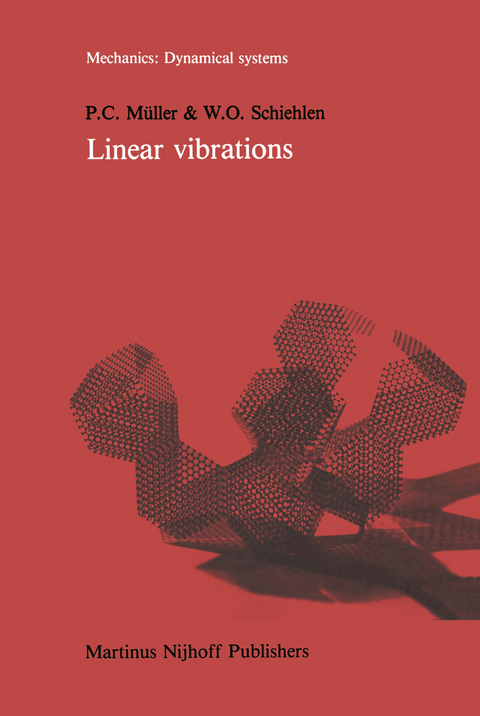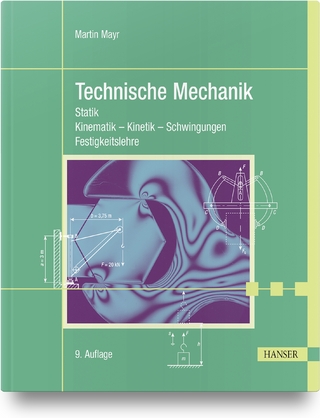
Linear vibrations
A theoretical treatment of multi-degree-of-freedom vibrating systems
Seiten
2013
|
Softcover reprint of the original 1st ed. 1985
Springer (Verlag)
978-94-010-8735-3 (ISBN)
Springer (Verlag)
978-94-010-8735-3 (ISBN)
As a rule, vehicles and machines have to be modelled as systems with many degrees of freedom such as multibody systems, finite element systems or con tinua. The present book deals with linear vibration analysis of technical systems with many degrees of freedom in a form allowing the use of computers for finding solutions.
In the last decade the development in vibration analysis was char acterized by increasing demands on precision and by the growing use of electronic computers. At present, improvements in precision are obtained by a more accurate modelling of technical systems. Thus, for instance, a system with one degree of freedom is often not accepted, as it used to be, as a model for vibration analysis in mechanical engineering. As a rule, vehicles and machines have to be modelled as systems with many degrees of freedom such as multibody systems, finite element systems or con tinua. The mathematical description of multi-degree-of-freedom systems leads to matrix representations of the corresponding equations. These are then conveniently analyzed by means of electronic computers, that is, by the analog computer and especially by the digital machine. Hence there exists a mutually stimulating interaction between the growing require ments and the increasing computational facilities. The present book deals with linear vibration analysis of technical systems with many degrees of freedom in a form allowing the use of computers for finding solutions. Part I begins with the classification of vibrating systems. The main characteristics here are the kind of differential equation, the time depen dence of the coefficients and the attributes of the exciting process. Next it is shown by giving examples involving mechanical vibrating systems how to set up equations of motion and how to transform these into state equations.
In the last decade the development in vibration analysis was char acterized by increasing demands on precision and by the growing use of electronic computers. At present, improvements in precision are obtained by a more accurate modelling of technical systems. Thus, for instance, a system with one degree of freedom is often not accepted, as it used to be, as a model for vibration analysis in mechanical engineering. As a rule, vehicles and machines have to be modelled as systems with many degrees of freedom such as multibody systems, finite element systems or con tinua. The mathematical description of multi-degree-of-freedom systems leads to matrix representations of the corresponding equations. These are then conveniently analyzed by means of electronic computers, that is, by the analog computer and especially by the digital machine. Hence there exists a mutually stimulating interaction between the growing require ments and the increasing computational facilities. The present book deals with linear vibration analysis of technical systems with many degrees of freedom in a form allowing the use of computers for finding solutions. Part I begins with the classification of vibrating systems. The main characteristics here are the kind of differential equation, the time depen dence of the coefficients and the attributes of the exciting process. Next it is shown by giving examples involving mechanical vibrating systems how to set up equations of motion and how to transform these into state equations.
I Mathematical description of vibrating systems.- 1. Classification of vibrations.- 2. Mechanical vibrating systems.- 3. State equations of linear vibrating systems.- II Time-invariant vibrating systems.- 4. The general solution of time-invariant vibrating systems.- 5. Stability and boundedness.- 6. Free vibrations.- 7. Forced vibrations.- 8. Resonance and absorption.- 9. Random vibrations.- III Time-variant vibrating systems.- 10. General solution and stability.- 11. Parameter-excited and forced vibrations.- IV Mathematical background.- 12. Controllability and observability.- 13. Matrix equations.- 14. Numerical aspects.- References.
| Reihe/Serie | Mechanics: Dynamical Systems ; 7 |
|---|---|
| Übersetzer | S. Swierczkowski |
| Zusatzinfo | 89 Illustrations, black and white; X, 327 p. 89 illus. |
| Verlagsort | Dordrecht |
| Sprache | englisch |
| Maße | 155 x 235 mm |
| Themenwelt | Naturwissenschaften ► Physik / Astronomie ► Mechanik |
| Technik ► Maschinenbau | |
| ISBN-10 | 94-010-8735-0 / 9401087350 |
| ISBN-13 | 978-94-010-8735-3 / 9789401087353 |
| Zustand | Neuware |
| Haben Sie eine Frage zum Produkt? |
Mehr entdecken
aus dem Bereich
aus dem Bereich
Statik - Kinematik - Kinetik - Schwingungen - Festigkeitslehre
Buch | Hardcover (2021)
Hanser, Carl (Verlag)
29,99 €


